Fokker D.VII (OAW)
ProfiPACK
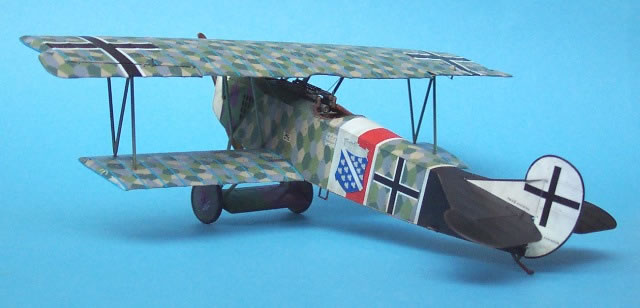
Eduard, 1/48 scale
S
u m m a r y |
| Catalogue Number: |
Eduard Kit No. 8131 - Fokker D.VII (OAW) ProfiPACK |
| Scale: |
1/48 |
| Contents and Media: |
Olive coloured plastic parts; photo-etched parts; markings for one aircraft. |
| Price: |
USD$39.95 plus shipping available online from Eduard's website
and specialist hobby retailers worldwide |
| Review Type: |
FirstLook |
| Advantages: |
Clean crisp mouldings; excellent fit with impressive attention to detail; accurate outline; good use of photo-etched parts; handy masking set; decals in perfect register with minimal carrier film. |
| Disadvantages: |
“Lozenge” decals still need some refinement. |
| Recommendation: |
Although a re-release of previous colour schemes, this boxing still has a lot going for it. The Fokker D.VII remains one of easier WWI aircraft to build and the “ProfiPACK” format allows the modeller to bring their subject up to a higher level of finesse. |
Reviewed by
Rob Baumgartner

Eduard's 1/48 scale Fokker D.VII (OAW) is available online from Squadron.com
Eduard’s latest release in the Fokker D.VII family is the license built OAW version. The Ostdeutschen Albatros Werken made quite a few changes to the pattern aircraft they received, resulting in some rather significant differences.
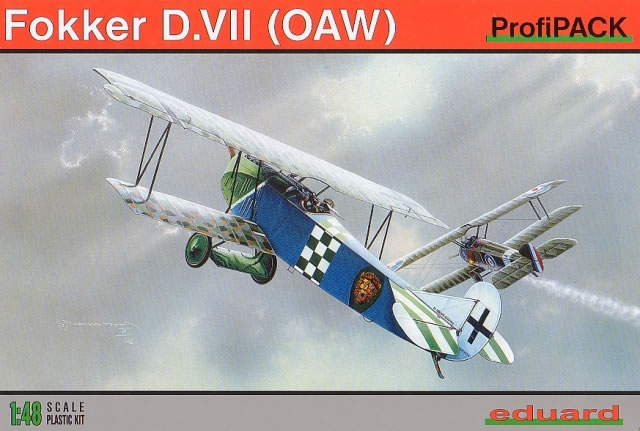
The most obvious of these was area around the engine, where over time various modifications were made to the cooling apertures. These can be found on sprue “D” which specifically caters for the OAW version. Both mid and late production options can be found, with the included fuselage halves representing each particular layout. These are characterized by the semi-circular vents of the former and the vertical slot arrangement on the latter.
Inside the box we find 4 sprues in the familiar tan coloured plastic. These contain a total of 92 parts, which are cleanly moulded and exhibit excellent detail. Being a “ProfiPACK” edition, the modeller also receives a fret of 115 photo-etched items, a set of express masks, and a decal sheet, that includes both upper and lower surface “lozenge”.
The cockpit is the first area to receive attention and here one finds a partial representation of the inner structure. This is moulded to the fuselage halves and is complimented by the usual fare such as the floor, rudder bar, seat, control column, compass and ammunition containers. Not forgotten are other essentials which include the seat mounts, fuel pressure pump, instrument panel and rear fabric screen.
Further enhancement comes courtesy of the photo-etched items. Many of these are pre-coloured and the seatbelts, instrument panel, dial faces, and placards are all catered for. Standard p-e items embellish this area with the switches, magneto, foot plates and bezels also coming into play.
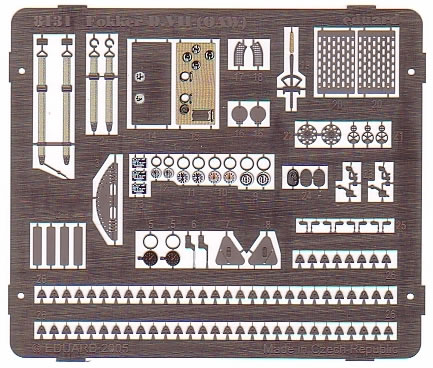
In these examples, printed fabric was used to cover the fuselage. Thus it is refreshing to find that Eduard have supplied a “reverse” pattern to reflect the visible bleeding through of the dye. These pre sized decals fit effortlessly into their allotted positions.
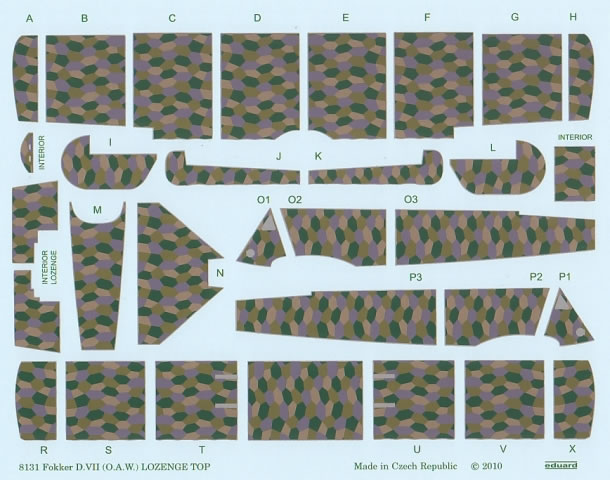

The engine must be added before closing up the fuselage halves and this sits neatly on a shelf at the front of the aircraft. Everything fits exactly as it should with precise location points and clear instructions.
Each wing is of single span and comes with upper and lower halves. The trailing edges are commendably thin and all rib locations are represented by moulded on “tapes”. If you wish to animate your aircraft, this can be easily done thanks to the separate ailerons, elevators and rudder.
Take care when attaching the lower wing as some anhedral can eventuate from the tight fit. A smidgen of sanding on the inner surfaces will fix this quite easily. In common with the rest of Eduard’s D.VII series, the completion of the assembly process is typically straight forward.
To give your subject with a little bit more finesse, the rest of the p-e provides detail for the machine guns (including the fretted jackets), strut brackets and trust plate, and foot placements.
Eduard has found a clever way of eliminating the lower fuselage seam. This is accomplished by incorporating a plastic strip to replicate the undersurface stitching. It fits perfectly and looks great under either a coat of paint, or “lozenge” decal.
Always worthy of praise is Mark Miller’s superb colour illustrations. These are found at various intervals of the instruction booklet and show how to paint and “super detail” the stage under construction. The novice will enjoy the minimal rigging on the D.VII and this is also adequately shown.
Markings
The modeller gets to choose between 4 machines, all of which have appeared before in this series.
As well as a sheet containing the national and personal markings, Eduard also supply the 4-colour lozenge. This time around, the printed fabric is devoid of the “weathering” that caused a bit of confusion amongst modellers when it first came out. Another issue was the transposition of two upper surface colours and this state of affairs remains the same here.
Although the pattern is precut to match the aircraft’s shape, those needing to be place beneath the cockpit do not reach down to the top of the lower wings. This painful situation must be fixed with a matching piece of leftover material.
Despite the above, these decals are very well printed with excellent registration and minimal carrier film. Stenciling is included on the sheet, as are logos, instrument faces, and a rigging diagram.
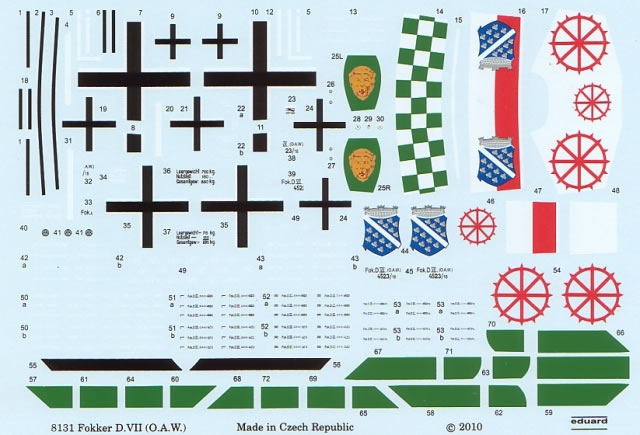
Rib tapes are supplied in two flavours, these being light blue and salmon pink.
Options
- Hasso von Wedel, Jasta 23
This was a BMW powered machine and wore Wedel’s family crest on the fuselage sides. Strictly speaking, it should be illustrated wearing 5 colour printed fabric, which the modeller will have to be source elsewhere. He was a 5 victory ace that survived the war and later flew in WWII where he was shot down during the Battle of Britain.
- Franz Büchner, Jasta 13
Büchner was one of the higher scoring pilots, finishing with a total of 40 victories. All but one was scored with Jasta 13, and his exploits won him the Pour le Merite on 23 October 1918. Although he lived through this conflict, he was to lose his life a couple of years later while flying for the Reichwehr during the post-war revolution.
The indicated striped tailplane for his D.VII goes against conventional wisdom and one has to wonder where Eduard found this snippet of information.
- Rudolf Stark, Jasta 35
Stark is credited with 11 confirmed victories; 5 came while serving with Jasta 34, 1 with Jasta 77, and his final 5 with Jasta 35. He survived the war and wrote a book about his adventures titled “Wings of War”.
- Unknown pilot of Jasta 58
Unfortunately the flyer of this aircraft is unknown but it does wear the white nose and black tail/rear fuselage of Jasta 58. The Kassel city coat of arms is present on the sides and its covering is of the 4-colour printed fabric variety.
With their one-piece fuselages, these are clearly the easiest to build D.VIIs in the marketplace.
Accuracy is excellent with the major parts precisely matching the respected general arrangement drawings of Ian Stair. Assembly is also not an issue as long as one carefully dry-fits everything before committing any glue.
Although the subjects represented in this release have been seen in previous offerings, many modellers may have missed them first time around. Now is your chance to remedy this and build one of the finest aircraft to fly in the German Air Service.
Thanks to Eduard for the sample
Review Text and Images Copyright © 2010 by Rob Baumgartner
Page Created 30 March, 2010
Last updated
30 March, 2010
Back to HyperScale Main Page
Back to Reviews Page

|
